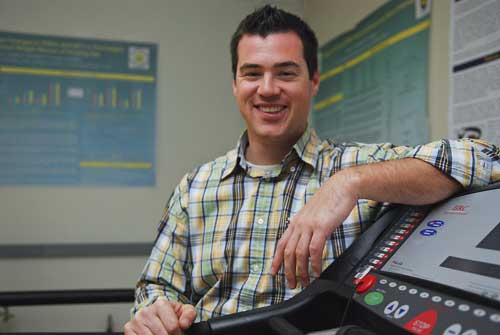Dr. Tom Hazell has got a deal for you. Give him just 30 minutes of exercise, three times a week, and your return is a loss of fat mass and gain in muscle mass that rivals and even betters longer and more sustained workout regimens.
No, it's not an infomercial pitch; rather it's laboratory research that shows intense interval training can not only provide the results many people are looking for when they go to the gym, but also can do so in a quick and efficient manner.

Hazell is one of the University's newest recruits, a member of the Department of Kinesiology who came on board in August. A week after he'd arrived, he was one of four keynote speakers at the Exercise Physiologists of Western Canada Conference hosted by the U of L.
"It was great to get thrown into things quickly and really good to get exposure to the Western Canadian kinesiologists," says Hazell, who earned bachelor, master's and PhD designations in kinesiology at McMaster, Windsor and Western universities, respectively. He also did a post-doctoral fellowship in pediatric nutrition at Montreal's McGill University.
Young, athletic and a former hockey player, Hazell says he excelled at both sports and science while growing up, pointing him towards the study of kinesiology. He knew he found his calling as a professor when he first started giving lectures as a master's student.
"I don't really consider it working because it's my passion and what I'm interested in," says Hazell. "If I'm not here in the lab or teaching, I'll be at home reading the latest articles trying to find things that I can incorporate into my research – it's just what I love to do."
His work in investigating interval training techniques really took shape during the first few years of his PhD studies. Using the universally renowned Wingate Anaerobic Test (pedaling a mechanically braked bicycle ergometer), he and his team discovered that 30-second bursts of all-out effort, followed by four minutes of rest and repeated four to six times in a session yielded potent results.
"Within two weeks we found you could increase your VO2 max (maximal aerobic capacity) by 10 per cent, and this in just over six sessions," says Hazell. "We then did a six-week study where the main outcome was body composition and we found that participants lost a similar amount of fat mass and gained lean mass with about one third the training volume similar to doing 30 to 60-minute runs on a treadmill."
It's not as easy as it sounds though, because all-out really means all-out.
"You really have to be motivated because all-out is difficult to do for 30 seconds. After about 10 seconds you're completely fatigued and you still have to push for another 20 seconds," says Hazell.
Working at the U of L, he sees multiple opportunities to collaborate with his colleagues in kinesiology on projects that will take this research to the next level.
"The question I want to start tackling now is what else is this training doing? How does it affect your appetite, so let's look at the physiology of it," he says. "I'd like to eventually get the funding to get some equipment so that I can look at the bone aspect of this. Can interval training help osteoporotic people who otherwise can't do impact exercise for any sustained time stimulate bone growth or even minimize bone loss?"
Right now, he's just looking at filling out his lab and getting as many students involved in his research as possible.
"One of the main reasons I got into being a professor was to mentor students," he says. "Some of the relationships I had with students who were senior to me, or my advisors, are lifelong. Both my PhD and master's advisors are now two of my better friends, and those are some of the relationships that drove me to do what I do."
GET THE FACTS
· Hazell has also studied whole body vibration and how combining workouts with vibration plates can further stimulate muscles and burn more calories
· Born and raised in Hamilton, Ont., Hazell moved to Lethbridge with his fiancé, who is originally from Calgary. She is working as an educational assistant with autistic children in Lethbridge School District No. 51
· He has been wowed by the facilities at the U of L, particularly the 1st Choice Savings Centre for Sport and Wellness. "Having been at McMaster, Windsor, Western and
McGill, the U of L's facilities really are state-of-the-art and I think people are spoiled if they don't realize it. This is one of the nicest gyms I've ever been in."
This story first appeared in the September 2012 issue of the Legend. For a look at the full issue in a flipbook format, follow this link.
